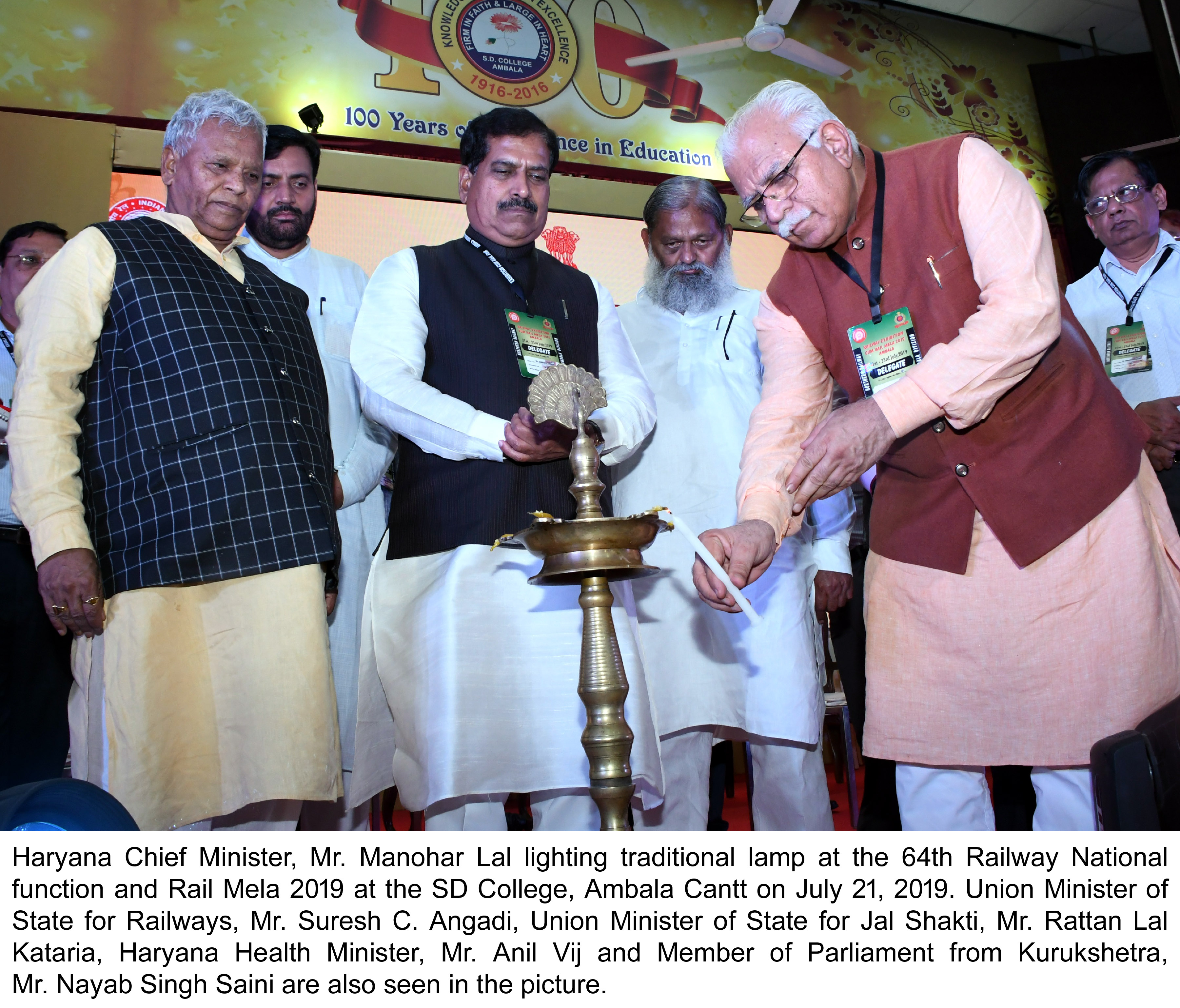
Chandigarh, July 21 – Haryana Government has started various initiatives to make the youth of the state efficient and employable through the Saksham Haryana scheme, which will prove to be a milestone in the coming time. In this series, a state-wide system is being developed for skillful changes in the youth, which will make the youth of Haryana to get employment by preparing them for the needs of the industries at the earliest.
While stating this here today, a spokesman of the Skill Development and Industrial Training Department said that achieving the mission of Kaushal Bharat (Skill India), which is to train a minimum of 30 crore people across the country by 2022, is an uphill task across states. While the Central Government has taken crucial steps to ease regulatory compliance and information flow, certain endemic challenges, such as information asymmetry, quality of training, and industry relevance have to be effectively addressed.
The Haryana Skill Development and Industrial Training (SDIT) Department is attempting to solve the skilling challenge through a systemic, state-wide transformation programme, Saksham Haryana. A flagship programme of the Haryana Government, Saksham Haryana aims to ensure career advancement of students, who enter Industrial Training Institutes (ITIs) and who take up short-term training. This involves the transformation of two key components of skilling, which included ITIs and short-term schemes. It also includes the tying together all efforts in this domain under one umbrella for a coordinated effort. Michael and Susan Dell Foundation (MSDF) and Samagra, a governance consulting firm, are helping the Department in this endeavor.
Over the last four years, Haryana has been at the forefront of solving a lot of skilling issues on the supply and demand side. Beginning with the Shri Vishwakarma Skill University (SVSU), the India’s first government skills university, the Department anchored the skilling ecosystem in a strong institutional and academic framework. More than 10 top industries such as Bikanervala, HDFC and Concentrix participated in this transformation across 15 courses. Subsequently, the formation of Haryana Skill Development Mission (HSDM) ensured effective delivery of short-term training programmes.
He said that one of the interventions is building a common platform through HSDM to act as a publicly accessible repository of all the short-term skilling courses in Haryana. Similarly, a public star-rating of all government ITIs on three outcome categories, viz., career advancement, quality of training and industry exposure is planned. A version of this star-rating was launched by the Chief Minister, Mr. Manohar Lal in Rohtak. The Department will link this to the counselling portal for admission into ITIs. This, coupled with our already live ITI assessment dashboard, will ensure that students seeking admission into ITIs are making an informed choice for the best available ITI/trade (the mentioned links can be found on website – itiharyana.gov.in).
The Department is introducing new academic pathways for students to increase their career opportunities. Academic equivalence, for instance, has been provided through a notification by Haryana Board of Secondary Education this year. Now, ITI students can be treated at par with their peers graduating from 10th or 12thgrades. Haryana is the first and only state to introduce a comprehensive academic equivalence policy. Until recently, the only option for passing out ITI students was to join the workforce or take up a diploma course in polytechnic colleges. Similarly, Shri Vishwakarma Skill University (SVSU) has embarked on a journey to develop a credit framework policy for the state. Once implemented, a student under any institution (ITI, College, Polytechnic, Vocational course or Short-term training) across the state will earn credits for every subject/course they study. A combination of these credits will lead to a certificate, diploma, bachelors’ degree, master’s degree or relevant qualification.
In the past few months, the Department has made efforts in addressing the quality of training in ITIs. The Department has begun procuring more than Rs.150 crore worth of equipment and machinery for every ITI. It has addressed the issue of availability of trainers partly through rationalization of their postings and partly through contractual recruitment. As a long-term solution, the Department has initiated recruitment of more than 2,500 permanent staff. By creating a central assessment cell and placement cell in the department, the Department has streamlined work on the quality evaluation of a student’s skills and their linkage to livelihood. While these efforts are underway across all government run ITIs, 23 model ITIs are being developed to act as a proof point of success. To track, monitor and guide these efforts, a robust ERP solution has been deployed to capture data in detail and to make informed decisions.
Apprenticeship is yet another focus area for the Department under Saksham Haryana. With more than 260 apprentices per lakh of population, Haryana is a pioneer in the country in this aspect. The Department has been closely working with the Union Ministry of Skill Development and Entrepreneurship to share the Department’s learning around the implementation of the Apprenticeship Act, 1961. States like Bihar, Madhya Pradesh, Uttar Pradesh and Rajasthan have been interacting with Haryana to take back some of these learnings to their states.
The Department has also begun to achieve the required reforms in short-term skilling by strengthening HSDM. Currently, ministries in Government of India and departments in the Haryana Government run skilling schemes with varying objectives, funding patterns, and quality control. To reform the ecosystem, the Department has begun to standardize basic aspects of managing a short-term training course across all Haryana Government run schemes. Additionally, HSDM has undertaken a massive exercise to transform the implementation of its short-term skilling schemes. This will become a proof point of success for other schemes to follow suit.
Through Udyog Mitra, the Department is planning to pivot the short-term ecosystem around industries to help build an industry owned model to produce higher quality outcomes. The Department will be working with industries directly to help source and skill youth in job roles of their requirement. To incentivize placements, the government will bear a portion of the EPF of the placed youth. The Department will also be providing a one-time bulk financial incentive for those, who hire youth through this scheme. A psychometric and aptitude test of youth will be conducted to enable them to make an informed choice about their career.
Envisioned first in the Haryana Enterprise Promotion Policy (HEPP), 2015, the Department has opened up the campuses and facilities of our polytechnics and ITIs to the wider sector of training providers and industry training partners. The Department hope that these organizations will leverage the existing infrastructure during the weekends or holidays to run their training programmes.
While all of these interventions are underway, the Department believes that a fundamental shift in the skilling ecosystem is required. The curriculum is often not insync with emerging industry needs because every year or so, newer technology, tools and organizations are seizing market opportunities. Procuring new machinery to match industry trends is a costly affair. Furthermore, professional skills such as leadership and communication are becoming ever more crucial for industries to operate at their optimum efficiency. Thus, the Department is pivoting towards a Dual System of Training (DST), which allows for students’ to spend most of their time working in the industry while enriching this through classroom learning. Through this, students can acquire technical knowledge in theclassroom and acquire training and professional skills in the industry.
The Department has signed signed over 70 MoUs with various leading industries to support it in piloting DST this academic year. The objective is to make this model scalable and sustainable for a state-wide rollout. DST courses will be structured in a way to ensure students benefit from training with relevant equipment in an industry setting. Industry partners will benefit from the ready manpower that students provide. Industries may also absorb students after two years since the students will have been skilled as per the needs of the industry. The relaxation of DST norms by Government of India in response to the feedback from the field is a welcome step towards encouraging industries to partner with ITIs across the country.



